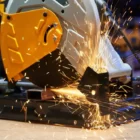Industrial cutting tools stand out as indispensable tools in the manufacturing and production sectors today. These tools, used in a wide range of applications from metal processing to wood processing, from the automotive industry to the aviation industry, are constantly evolving with the advances in material processing technologies. In this article, we will try to understand the role of these critical tools in modern manufacturing processes by providing an in-depth look at the basic operating principles of industrial cutting tools.
The selection and use of industrial cutting tools involves a number of complex factors, such as the variety of material types, design features, and processing methods. By covering these elements in detail, this article will focus on understanding how industrial cutting tools work effectively and how they are optimized in production processes.
First, the material selection and design processes of industrial cutting tools will be examined. Then, cutting edge formation techniques and the effects of these techniques on the cutting performance of the tools will be discussed. The chip formation process, which is an integral part of machining, will be explained in detail and the effects of this process on material processing quality will be discussed. How cooling and lubrication systems are used to increase the durability of tools and control the heat generated during machining will be discussed in detail.
Finally, we will focus on the speed and feed settings of the cutting tools. How the optimum speed and feed settings that need to be determined for each material type are determined in industrial applications and the effects of these settings on the efficiency of the tools will be examined.
This detailed analysis will help us understand how industrial cutting tools function as one of the defining elements of modern production processes, rather than just tools.
Material Selection and Design
Proper material selection and design are critical for the effective operation of industrial cutting tools. The properties and usage areas of hard materials such as carbide, ceramics and diamond will be examined in detail. In addition, we will focus on what to consider when choosing a tool based on material properties and which design is advantageous for which material.
Creating a Cutting Edge
The main function of cutting tools is the ability to cut material. How do the grinding techniques used to create a sharp cutting edge affect the performance of tools? Optimum cutting edge creation methods will be explained, focusing on the geometry, angle and microscopic details of the cutting edge.
Chip Formation
The chips created by cutting tools during processing play a critical role in the processing of the material. Detailed examination of the chip formation process; The effects of chips on the machining process will be explained by focusing on chip type, size, and different chip formation characteristics in various materials.
Cooling and Lubrication
The functioning of the cooling and lubrication systems used to control the heating of cutting tools operating at high speeds will be explained in detail. The effects of cooling and lubrication on the life of the tool will be explained with examples from specific systems used in different industrial applications.
Speed and Feed Settings
The optimum cutting speed and feed rate must be determined individually for each type of material. How these parameters are set and affected, and the effects on the efficiency of cutting tools will be explained in detail. With examples from real industry applications, we will focus on how to adapt speed and feed settings to the workpiece material properties.
Conclusion
Industrial cutting tools play a fundamental role in modern manufacturing processes. With advances in material processing technologies, the emergence of more durable and effective cutting tools makes it even more important for industry professionals to choose these tools correctly. Understanding the operating principles of cutting tools is a critical factor for success in industrial production.
werte As Cutting Technologies, we aim for the best in every cut. We strive to make everyone perfect with our excellent products and great after-sales support.





